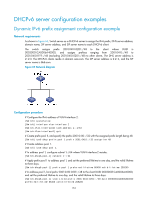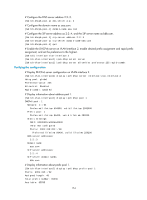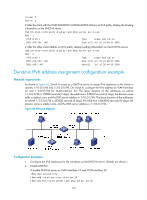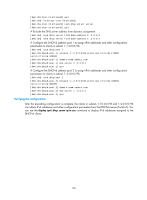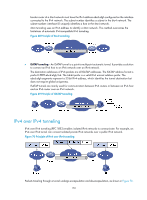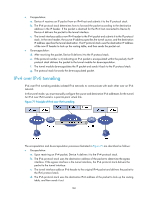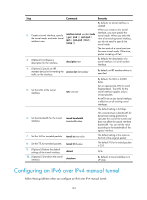HP 6125XLG R2306-HP 6125XLG Blade Switch Layer 3 - IP Services Configuration G - Page 166
Tunnel modes, Destination IPv6 address
 |
View all HP 6125XLG manuals
Add to My Manuals
Save this manual to your list of manuals |
Page 166 highlights
4. If the destination address of the IPv6 packet is itself, Device B forwards it to the upper-layer protocol. If not, Device B forwards it according to the routing table. Tunnel modes IPv6 over IPv4 tunnels include manually configured tunnels and automatic tunnels, depending on how the IPv4 address of the tunnel destination is acquired. • Manually configured tunnel-The destination IPv4 address of the tunnel cannot be automatically acquired from the destination IPv6 address of an IPv6 packet at the tunnel source, and must be manually configured. • Automatic tunnel-The destination IPv4 address of the tunnel can be automatically acquired from the destination IPv6 address (with an IPv4 address embedded) of an IPv6 packet at the tunnel source. According to the way an IPv6 packet is encapsulated, IPv6 over IPv4 tunnels are divided into the following modes. Table 10 IPv6 over IPv4 tunnel modes and key parameters Tunnel type Manually configured tunnel Tunnel mode IPv6 over IPv4 manual tunneling Tunnel source/destination address The source and destination IPv4 addresses are manually configured. Destination IPv6 address format Ordinary IPv6 address. 6to4 tunneling Automatic tunnel ISATAP tunneling The source IPv4 address is manually configured. The destination IPv4 address is automatically obtained. 6to4 address, in the format of 2002:IPv4-destination-addres s::/48, where the IPv4-destination-address is the IPv4 address of the tunnel destination. The source IPv4 address is manually configured. The destination IPv4 address is automatically obtained. ISATAP address, in the format of Prefix:0:5EFE:IPv4-destinatio n-address/64 where the IPv4-destination-address is the IPv4 address of the tunnel destination. • IPv6 over IPv4 manual tunneling-A point-to-point link and its source and destination IPv4 addresses are manually configured. You can establish an IPv6 over IPv4 manual tunnel to connect isolated IPv6 networks over an IPv4 network, or connect an IPv6 network to an IPv4/IPv6 dual-stack host over an IPv4 network. • 6to4 tunneling-A point-to-multipoint automatic tunnel. It is used to connect multiple isolated IPv6 networks over an IPv4 network. The destination IPv4 address of a 6to4 tunnel is embedded in the destination 6to4 address of packets. This mechanism enables the device to automatically get the tunnel destination address, simplifying tunnel establishment. The 6to4 address format is 2002:abcd:efgh:subnet number::interface ID/48, where 2002 is the fixed IPv6 address prefix, and abcd:efgh represents a 32-bit globally unique IPv4 address in hexadecimal notation. For example, 1.1.1.1 can be represented by 0101:0101. The IPv4 address identifies a 6to4 network (an IPv6 network where all hosts use 6to4 addresses). The 158



